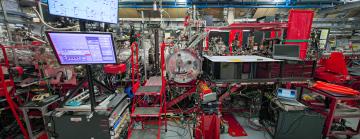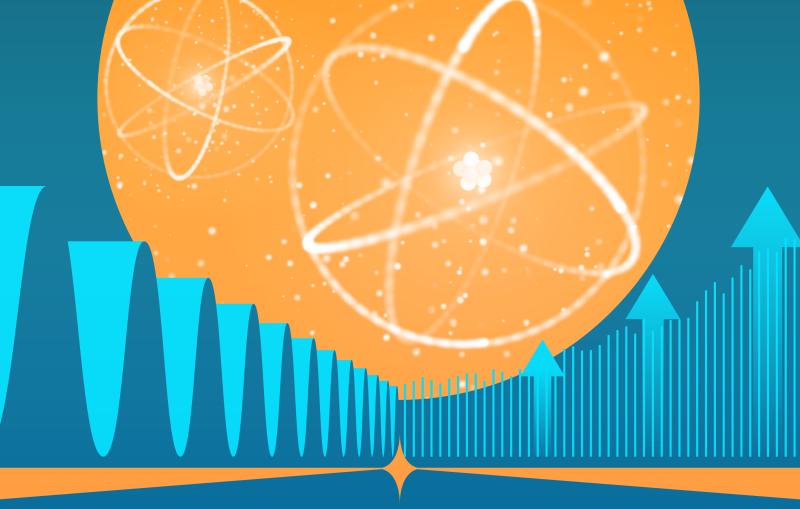Illuminating the dance of RNA with ultrabright X-rays
Scientists developed a new method to unlock the secrets of RNA. The implications are wide-reaching, from better understanding diseases to designing new therapeutics.
DNA, RNA, and proteins are three pillars of molecular biology. While DNA holds genetic instructions and proteins put these plans to action, RNA serves as the messenger and interpreter. DNA is transcribed to RNA, which then decodes those instructions to synthesize proteins. But large portions of RNA don't proceed to produce proteins, with a vast majority remaining just as RNA. What these molecules do or why they exist in such a state is still not fully understood.
Now, scientists have developed a promising method to uncover RNA’s secrets. Using X-ray free-electron laser sources such as the Linac Coherent Light Source at the Department of Energy’s SLAC National Accelerator Laboratory, researchers can now observe fine details, right down to angstrom-scale features, in RNA that is freely dispersed in solution so that large scale structural changes can occur – just as they would in our bodies. Not only does this research shed light on RNA's behavior, but the techniques developed can also be applied to other biological molecules. The implications are far-reaching, from better understanding diseases to designing new therapeutics. The results were published last week in Science Advances.
Mixing and Scattering
For decades, researchers have studied protein structures to understand their behavior and role. RNA, like proteins, has its own choreography—how it twists, turns, and folds. These "dances" dictate their function. However, RNA molecules are more challenging to study because they are highly charged and very flexible, making it tricky to pinpoint their structures.
When probed with X-rays, RNA displays certain repeating patterns that reflect snapshots of its structural makeup. These so-called "scattering signatures" are incredibly faint and hard to measure even in samples that are not changing in time. Watching them transform is more challenging, because very small volumes of sample are required to isolate short time scales with X-rays. To see these molecules change on the biologically relevant, millisecond time scale, researchers need a powerful probe beam focused on a tiny spot. LCLS has now been shown to provide a bright enough beam to capture these scattering signatures, allowing scientists to view changing RNA structures in unprecedented detail.
The research team led by Lois Pollack, a professor at Cornell University, modified their specialized liquid injectors to be able to study how biomolecules react when mixed with a chemical trigger. The special mixing injectors, designed and built by Pollack’s graduate student Kara Zielinski, sent freely floating RNA molecules into the path of the LCLS beam in a liquid jet.
Just milliseconds before the RNA molecules were hit with the X-ray laser beam, they were combined with magnesium ions inside the mixing injector. The ions triggered dramatic shape changes in the RNA molecules as they “folded” into their final structure. Ultrabright X-ray pulses lasting for just millionths of a billionth of a second then measured the resulting changes in the RNA’s structure. By combining many of these measurements in a stop-motion X-ray molecular movie at successive time delays after the introduction of magnesium – the researchers were able to follow structural changes in the RNA.
With this technique, the researchers captured an RNA molecule's large structural transformation from unfolded to folded. Over milliseconds, an RNA strand evolved from a single-stranded state through a partially double-helical intermediate, eventually taking on a triple-helix shape.
Live performance
A highlight of this research was the real-time analysis, in which the molecular movie was reconstructed using powerful computers just a few minutes after the measurements were taken. Until now, researchers had to be patient, collecting data for long durations before understanding the outcomes. In this research, the team could witness the structural changes in RNA as the experiments unfolded and analyze data on the fly. It was akin to watching a live broadcast of RNA's dance, with each move and twirl signifying a change in its structure.
"The exhilaration was profound," recalls Pollack, "We were peeking at these molecules in real time, watching them fold and change shape."
To follow up, the team plans to combine high and low-resolution measurements, integrating them with simulations to offer a detailed atomic view of RNA's structure and behavior. This synergy between experimental observations and computational modeling could offer new insights into biomolecular interactions.
The punchline
While this research used a simple RNA model to ensure predictability, scientists are now equipped to observe, in real time, chemically triggered structural changes with immense detail and rapid speed. This could further unravel the mysteries of RNA structures.
The research should open doors for pharmaceutical advancements. With a deeper understanding of RNA structures, targeted drug designs can be refined to act more precisely and efficiently.
The team’s techniques extend beyond just RNA. Their technology, specifically the mixing injector, is versatile enough to study various other molecular interactions in proteins and DNA.
Reflecting on the broader impact, Pollack said, “It's not solely about this RNA discovery. It’s a realization that the tools at our disposal now empower us to witness intricate molecular events with unprecedented detail. The punchline is that we can now see in great detail on very short timescales.”
Citation: K. Zielinski et al., Science Advances, 27 September 2023 (10.1126/sciadv.adj3509)
For questions or comments, contact the SLAC Office of Communications at communications@slac.stanford.edu.
About SLAC
SLAC National Accelerator Laboratory explores how the universe works at the biggest, smallest and fastest scales and invents powerful tools used by researchers around the globe. As world leaders in ultrafast science and bold explorers of the physics of the universe, we forge new ground in understanding our origins and building a healthier and more sustainable future. Our discovery and innovation help develop new materials and chemical processes and open unprecedented views of the cosmos and life’s most delicate machinery. Building on more than 60 years of visionary research, we help shape the future by advancing areas such as quantum technology, scientific computing and the development of next-generation accelerators.
SLAC is operated by Stanford University for the U.S. Department of Energy’s Office of Science. The Office of Science is the single largest supporter of basic research in the physical sciences in the United States and is working to address some of the most pressing challenges of our time.






